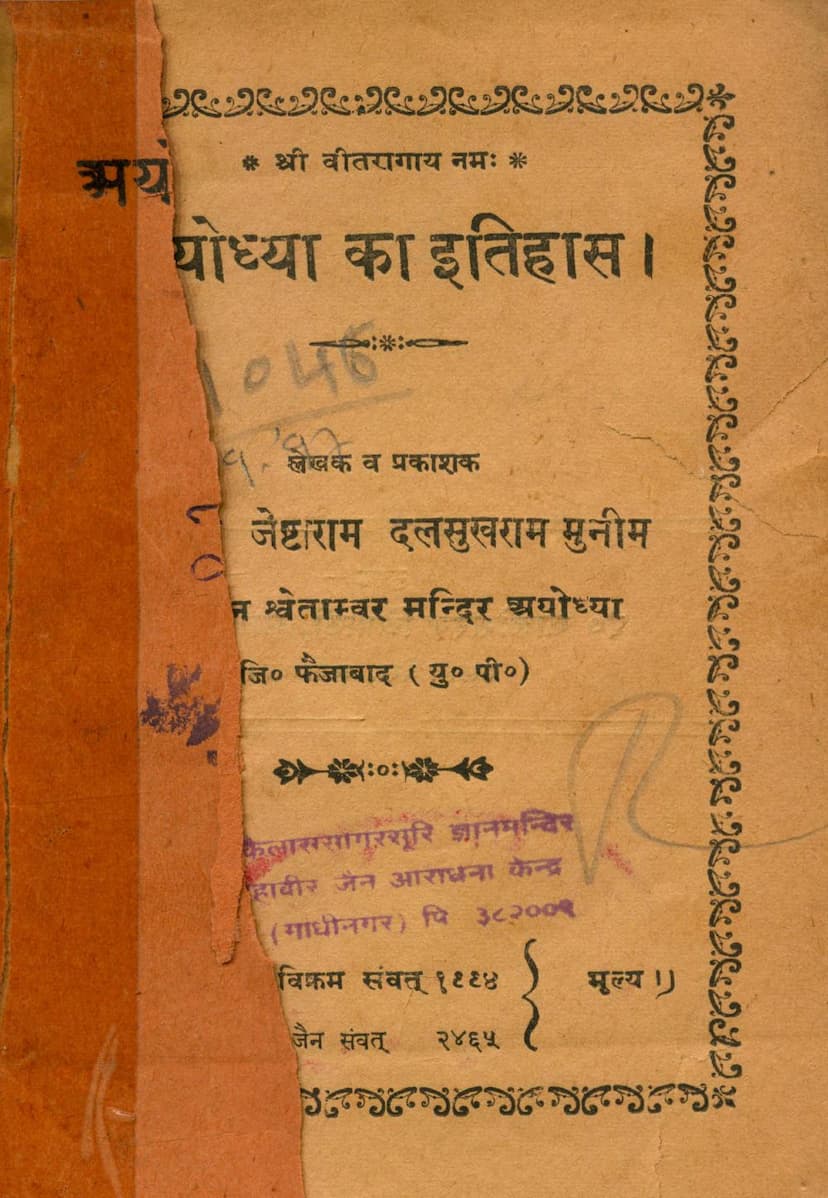Ayodhya Ka Itihas
Added to library: September 1, 2025

Summary
Here's a comprehensive summary of the Jain text "Ayodhya ka Itihas" by Jeshtaram Dalsukhram Munim, based on the provided pages:
Book Title: Ayodhya ka Itihas (History of Ayodhya) Author & Publisher: Jeshtaram Dalsukhram Munim Published: Vikram Samvat 1964 (2465 Jain Samvat) Printer: Kamla Press, Ayodhya
Overall Purpose and Context:
This book, "Ayodhya ka Itihas," aims to present a historical account of Ayodhya, with a particular focus on its significance from a Jain perspective. The author, Jeshtaram Dalsukhram Munim, a scholar associated with the Jain Shwetambar Mandir in Ayodhya, undertakes the ambitious task of tracing the history of this sacred city, highlighting its connections to various religious traditions, but with a special emphasis on its foundational role in Jainism.
Key Themes and Content:
-
Ayodhya as a Primordial and Sacred City: The book establishes Ayodhya not just as an ancient city but as a place of immense spiritual and historical importance. It's described as the birthplace of foundational figures in various religions, including Lord Rishabhdev (the first Tirthankar in Jainism), Lord Rama (in Hinduism), and a significant site for Buddhism.
-
Jainism's Deep Roots in Ayodhya: A central thesis of the book is that Ayodhya is the origin point of Jainism. It details the birth and early life of Lord Rishabhdev (Adinath) in Ayodhya, his ascension to kingship, and his subsequent renunciation to become the first Tirthankar. The text also mentions the birth of other prominent Jain figures and the activities of Jain Acharyas in Ayodhya.
-
Chronological Historical Account: The book is structured into several "Sargs" (chapters) that attempt to cover Ayodhya's history chronologically, from its mythological origins to its more recent past.
- Adi-kaal (Primordial Era): This section focuses on the divine and mythological origins of Ayodhya, its creation by celestial beings, and its association with Lord Rishabhdev and his son, Bharat Chakravarti. It describes the city's divine construction and its early inhabitants.
- Pauranik Kaal (Mythological Era): This section delves into the presence of various divine and heroic figures, including ideal women. It lists the various names Ayodhya has been known by and discusses the influence of Buddhism and Jainism during this period, mentioning Lord Mahavir's and Lord Buddha's visits.
- Aitihasik Kaal (Historical Era): This is the most extensive section, covering Ayodhya through various dynasties and historical events. It discusses:
- The Shishunag dynasty, Nanda dynasty (mentioning their adoption of Jainism), and the Maurya dynasty (Chandragupta, Ashoka, Kunal, Samprati).
- The rule of Vikramaditya, who is credited with rebuilding Ayodhya and establishing Jain and Buddhist temples.
- The invasions and destructions by figures like Mahmud Ghaznavi, Muhammad Ghori, and Babur, who are described as destroying Jain temples and constructing mosques in their place.
- The impact of various rulers, including the Guptas, Harshavardhan, and the Kayasth rulers who were patrons of Jainism.
- The decline of Ayodhya due to political instability, invasions, and religious conflicts.
- The role of Jain Acharyas like Shri Sthulibhadra, Shri Ayarya Sukhalasti Suri, Shri Ayarya Skandil Suri, Shri Ayarya Vajraswami, Shri Ratna Prabha Suri, and Shri Jinprabh Suri in preserving Jain dharma and defending its temples.
- Vartaman Kaal (Present Era): This section touches upon the efforts of later Jain scholars and philanthropists in the revival and upkeep of Jain sites in Ayodhya.
-
Ayodhya's Significance for Multiple Religions: While firmly rooting Ayodhya's history in Jainism, the author acknowledges its importance for Hinduism (birthplace of Lord Rama) and Buddhism (a place of worship and learning for Lord Buddha and his followers). This suggests an attempt to provide a comprehensive, albeit Jain-centric, historical narrative of the city.
-
Author's Motivation and Methodology: The author expresses his personal inspiration and dedication to writing this history. He states that he consulted various Jain scriptures, Buddhist texts, and Gujarati books. He specifically mentions referencing the "Ayodhya ka Itihas" written by Lala Sitaram, B.A., and the Avadh Gazetteer for his research. He also clarifies that his primary language is Gujarati, indicating the effort involved in writing in Hindi. He mentions the desire to serve the Jain faith and its pilgrimage sites.
-
Emphasis on Jain Heritage and Monuments: The book likely details specific Jain temples, statues, and significant locations within Ayodhya, such as the Kanak Bhavan and the sites related to the Kalyanaks (auspicious events) of the Tirthankaras. The mention of ancient statues found in a vault within the temple is significant.
-
Spiritual and Ethical Underpinnings: The preface and the opening verses emphasize the importance of truth, inner strength, and the advancement of a community through its intrinsic values. The author expresses gratitude to the authors whose works he consulted.
Key Figures Mentioned:
- Lord Rishabhdev (Adinath): The first Tirthankar, born in Ayodhya.
- Bharat Chakravarti: Son of Lord Rishabhdev, a powerful emperor associated with Ayodhya.
- Lord Mahavir: The 24th Tirthankar, whose teachings influenced the region.
- Lord Buddha: Whose presence and teachings are noted in Ayodhya.
- Vikramaditya: A historical king credited with rebuilding Ayodhya and promoting religions.
- Ashoka: The Mauryan emperor who patronized Buddhism and erected structures in Ayodhya.
- Samprati: A Mauryan king and a prominent Jain patron.
- Jain Acharyas: Shri Sthulibhadra, Shri Aryasuhasti Suri, Shri Jinaprabh Suri, Shri Jinamuni, and others who played a crucial role in the preservation and propagation of Jainism.
Overall Impression:
"Ayodhya ka Itihas" by Jeshtaram Dalsukhram Munim appears to be a scholarly and devoted work dedicated to highlighting Ayodhya's rich and multifaceted history, with a strong emphasis on its pivotal role as the cradle of Jainism. The author's meticulous research and his clear passion for the subject are evident throughout the provided text. The book seeks to reclaim and assert Ayodhya's historical and religious significance from a Jain perspective, countering the potential erasure of this heritage.